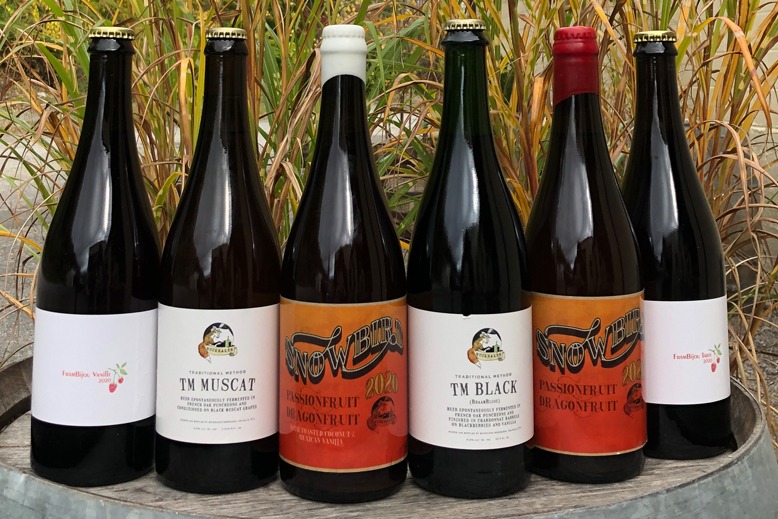
Lambics come in glass wine bottles. Their carbonation results from a second fermentation in the bottle, as in Champagne. Photo by Shelby Vittek
Unlike wine and cider—beverages that require fresh harvests of grapes or apples—beer, usually made from malted grains and dried hops, can generally be produced any time of year. At Muckraker Beermaker in Franklin, however, brewing is seasonal. That’s because owner and brewer Tom Troncone specializes in lambic brews, a type of sour Belgian beer made through an age-old process in which the unfermented liquid is exposed to local, naturally occurring wild yeasts and bacteria. This makes each batch a little different.
What all lambics have in common, though, are flavor profiles more like wine or cider than beer. “I brew what I like to drink,” Troncone says.
He chose the brewery’s spot in Sussex County in part for its proximity to an old quarry and nearby farms. “I thought we could get some good microflora from the surrounding woods,” he says.
Most beers are consumed within weeks of production, but lambics need aging in oak barrels and then again in the bottle before they’re ready to drink. At Muckraker, the process takes a year and a half. Brewing can begin when night temperatures fall below 45 degrees. Anything warmer would let unwanted bacteria flourish. In Belgium, home of lambic production, the season runs November through April. The climate in New Jersey favors October through late April.
[RELATED: The Man Who Helped Put Jersey Wineries on the Map]
Troncone starts by steeping raw wheat and malted barley in hot water, then boiling it with aged hops for up to four hours. This unfermented wort, as it’s called, is left out overnight in a shallow, open, steel vessel called a coolship. As the wort cools, it absorbs wild yeasts from the air. Compared to stirring in commercial yeasts in regular beers, “you don’t get a lot [of yeast] from the air, which is why it takes [overnight],” Troncone says. The next day, the beer is transferred to oak barrels to age.
Muckraker’s lambics, aged and complex, can be tart and/or dry. Sweeter ones are flavored with fresh fruit, spices or sugar. For the fruited lambics, Troncone sources local ingredients whenever possible, such as Jersey peaches and nectarines, as well as blueberries from the Pinelands. His kriek, a traditional Belgian lambic made with sour Morello cherries, features sour cherries from the Hudson Valley.
A self-described “recovering journalist,” Troncone worked as a reporter for New Jersey media such as the Record, Star-Ledger and Patch before opening Muckraker—named for the early 20th-century reporters who exposed political corruption and industrial exploitation.
When Muckraker opened in September 2019, it joined a very small group of brewers making lambic-inspired beers in New Jersey, most notably, the Referend Bier Blendery in Pennington. “Any industry evolves,” Troncone says. “We’ve been in the IPA style for a while. Now we’re seeing more spontaneous breweries.”



